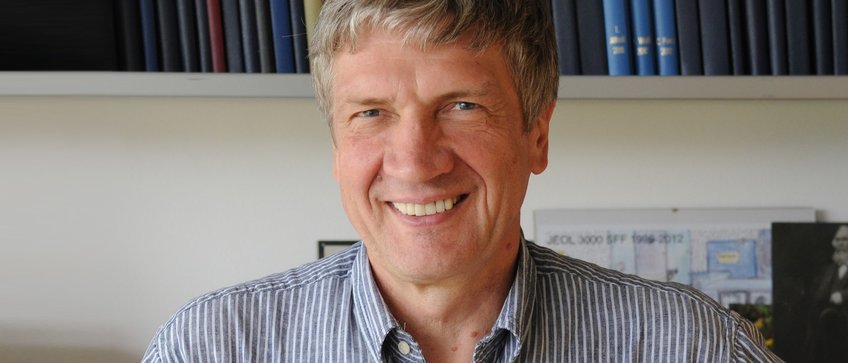
Cothenius Medal for Werner Kühlbrandt
Leopoldina honors Werner Kühlbrandt and Rudolf K. Thauer with Cothenius Medals for their scientific life's work
The Leopoldina National Academy of Sciences honors its members Werner Kühlbrandt and Rudolf K. Thauer with Cothenius Medals. The researchers receive this honor for their outstanding scientific life's work. The awards have been presented during the ceremonial opening of the Leopoldina Annual Assembly – subject to the then prevailing pandemic situation – on Friday, September 24, 2021, in Halle (Saale).


Prof. Dr. Werner Kühlbrandt (born 1951) researches the structure and function of membrane proteins located in the lipid membranes surrounding every cell. They are involved in vital processes such as substance transport, cell communication and the transmission of signals. In order to understand how they work, their precise spatial structure must be elucidated. To this end, the membrane biochemist and structural biologist has further developed analytical methods such as X-ray crystallography and cryo-electron microscopy (cryo-EM) and significantly improved their resolution. Werner Kühlbrandt has described the structures of various membrane proteins and their arrangements. He clarified the structure of the Light Harvesting Complex II, LHC-II. This membrane protein is essential for photosynthesis in green plants. In later work, he devoted himself to the structure and functioning of large membrane protein complexes in order to understand how these molecular assemblies supply cells with vital energy. Using cryo-EM and new detector technologies, he displayed the structure of complete ATP synthases from mitochondria and chloroplasts at high resolution. With the help of cryo-electron tomography, he was able to show how these complexes are arranged in the membrane and determine their shape. His research results provide new insights into how complex membrane transport machines are structured and how they fulfill their diverse functions in the membrane.
Werner Kühlbrandt studied chemistry and crystallography at the Free University of Berlin. Already during his studies he did research at King's College in London/UK. In 1981, he received his doctorate at the Laboratory of Molecular Biology of the Medical Research Council in Cambridge/UK. This was followed by research stays at the Swiss Federal Institute of Technology in Zurich/Switzerland, at the Imperial College London/UK and at the Lawrence Berkeley National Laboratory in Berkeley/USA. In 1988, he headed his first research group at the European Molecular Biology Laboratory in Heidelberg, where he worked until 1997. In the same year he became director at the Max Planck Institute of Biophysics in Frankfurt am Main, where he has since headed the Department of Structural Biology. Kühlbrandt has received numerous grants, prizes and awards, including a Long Term Fellowship from the European Molecular Biology Organization (EMBO) and funding under the Heisenberg Program of the German Research Foundation. He is a member of EMBO and the Max Planck Society as well as numerous scientific advisory boards. The Leopoldina appointed him as a member of the Biochemistry and Biophysics Section in 2003.
Prof. Dr. Rudolf K. Thauer (born 1939) is Professor Emeritus for Microbiology. He has made many important contributions to the biochemistry, physiology and ecology of anaerobic, i.e. those living without oxygen, microorganisms. His research has been devoted to the energy metabolism of bacteria and archaea, which can grow at H2 and CO2 atmosphere and play an important role in the global carbon cycle. Archaea, like bacteria, are small unicellular microorganisms. They have evolved separately from bacteria and eukaryotes (plants, animals, fungi) and therefore form a distinct domain of cellular life. Thauer examined mainly acetogenic bacteria and methanogenic archaea. These use the energy released during the formation of acetic acid and methane, respectively.
With his research group, he clarified the underlying metabolic pathways that lead from CO2 and H2 to acetic acid and methane, respectively. In the process, the microbiologist discovered that these organisms require nickel as a trace element for growth. Among other things, his group characterized several nickel enzymes involved in acetic acid and methane formation, as well as the nickel-containing coenzyme F430, whose chemical structure he clarified. In addition, he identified the biochemical coupling sites in which the energy released during acetic acid or methane formation is conserved. He described these results in more than 400 widely cited publications. He supervised 72 dissertations, ten habilitation theses and more than 100 other theses.
The Cothenius Medal goes back to a foundation of the Leopoldina member and personal physician of the Prussian King Frederick II, Christian Andreas von Cothenius (1708-1789). It was awarded for the first time in 1792. Initially, the prize winners were honored for their work on medical research questions. Since 1954, the Leopoldina has awarded the Cothenius Medals for the outstanding scientific life's work of the honorees. As a rule, the awards are presented to members of the Academy. Among the recipients are the physician and zoologist Ernst Haeckel (1864) and Konrad Zuse (1985), the developer of the first computer.













